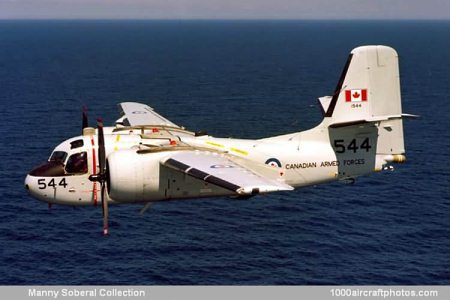Sub-contractors were Canadian Car and Foundry (wings), Canadair, (rear fuselage), Enamel and Heating Products (tail), MacDonald Bros. Aircraft (engine nacelles), Jarry Hydraulics (landing gear shock struts ), Dowty Equipment (nose landing gear, tail bumper), Fleet Manufacturing (doors, hatches, covers), and Canadian Pratt and Whitney (engines).
Two 1,525 h.p. Wright R-1820 82 WA nine-cylinder air-cooled radial engines were placed in large under-wing nacelles that also provided space for the main landing gear and rear-launched sonobuoys. The search radar antenna was fitted in a retractable dustbin radome beneath the rear fuselage. A retractable stinger Magnetic Anomaly Detection (MAD) boom was fitted in the tail and a steerable power searchlight was installed in a fairing beneath the starboard wing.
The 100 RCN aircraft, s/n 1501 to 1600, were of three major variants, the CS2F-1, the CS2F-2 and the CS2F-3. All used the same airframe but were different with respect to the anti-submarine and over-water navigation systems installed. The first aircraft, however, was an S2F, assembled from components supplied by Grumman to calibrate the tooling on the de Havilland Canada production line. Originally numbered X500, it was later upgraded to the CS2F-1 standard and assigned s/n 1501.
It was followed by 42 Canadian-built CS2F-1 aircraft s/n 1502 to 1543, the first flew May 31, 1956, seventeen of these were transferred to the MLD in 1960, and in 1964 two were converted to Carrier Onboard Delivery (COD) transports, carrying a crew of two and six passengers. The 57 CS2F-2 aircraft, s/n 1544 to 1600, were fitted with automated tactical navigation equipment. Armament consisted of torpedoes, depth charges located in the bomb bay, and torpedoes, depth charges or rockets carried on six under-wing attachments.
Of the previous versions 43 aircraft were modernized to the CS2F-3, including a second generation automated tactical navigation computer, doppler radar, and other updated equipment. With the integration of the RN into the CAF, the remaining 57 aircraft were redesignated CP-121 and soon thereafter received new serials in the range 12101 to 12199, retaining the last two digits of their previous serial. (The pictured CP-121 carries the CAF livery, but still the old serial.)
Beside their ASW-tasks, the Tracker has also been used for fisheries patrols, pollution surveillance, and anti-drugs missions. Struck off charge a number started a second life as fire-fighters, eventually re-engined with turboprops.
Span: 72 ft 7 in (22.12 m)
Span wings folded: 27 ft 4 in (8.33 m)
Length: 43 ft 6 in (13.26 m)
Height: 17 ft 6 in (5.33 m)
Wing area: 485 sq.ft (45 sq.m)
Weight empty: 18,315 lb (8,306 kg)
Max take off: 26,147 lb (11,860 kg)
Max speed: 280 mph (451 kmh) at sea level
Patrol speed: 150 mph (241 kmh)
Service ceiling: 22,000 ft (6,706 m)
Range: 1,350 mls (2,173 km)
Endurance: 9 hr
